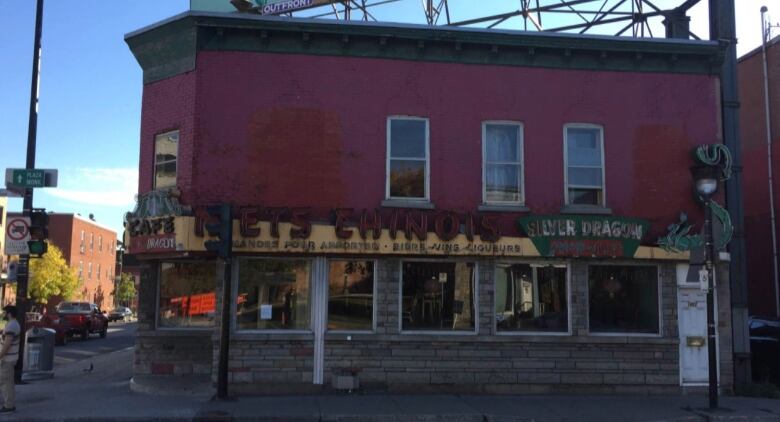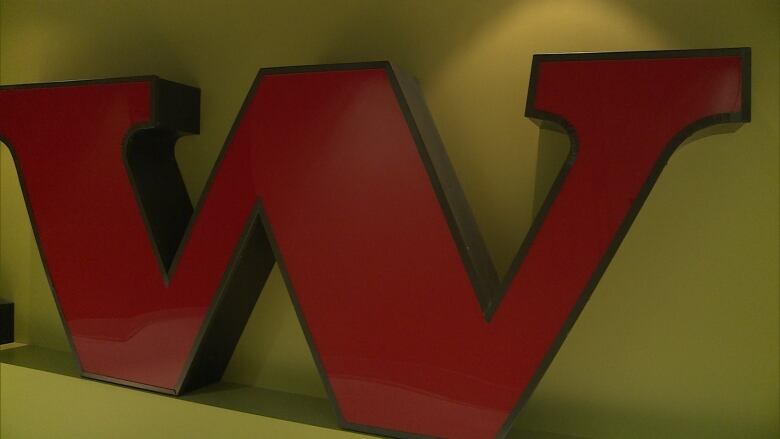Decaying neon Silver Dragon latest addition to Montreal Signs Project
Vintage sign collection links Montrealers to the city's history

Are you one of the residents of Montreal's Southwest borough who's been wondering what happened to the Silver Dragon Chinese restaurant's decaying neon sign?
Have no fear. Matt Soar has rescued it.

TheMetsChinoissign went up on the corner of DeL'gliseandLaurendeaustreets 60 years ago this month, Soar's research found. It came down just weeks ago.
"It's full of dead pigeons and birds' nests and broken neon and peeling paint," said theConcordiaUniversity professor of communication studies. "But I think it has some amazing stories to tell."

Soar understands intrinsically how passionately people feel about the signs that grace the city.
One of the first things henoticed when he moved to Montreal more than a decade ago was the sheer number of signs.
Soar, who also has a background in graphic design, became interested in the esthetics of the signs, and soonhe began collecting them.
He founded the Montreal Signs Project and began actively seeking landmark signs across the city.
"A lot of people in the city care about some of the signs in really interesting kinds of ways," he says.

Signs of the times
Close to a dozen old signs adorn the walls of the communication studies and journalismbuilding on the university's Loyola campus.
Each has a story to tell, Soarsays.

There's theMonklandTavern sign on the main floor.
It's a trendy restaurant now, but the tavern used to be a smoky watering hole where men would rub elbows and argue about politics and the MontrealCanadiens.
The sign graces the wall thanks, in part, to the language police. Missing an 'e' on the end, the spelling contravened the province'ssignagelaws and had to be removed.
Soar believes the iconic sign dates back to the 1940s.

The Warshaw Supermarket on St-Laurent Boulevard served customers for close to fifty years before shutting its doors in 2002.
Soar believes the giant red letters date back to the 1950s. A sprawlingpharmacy has taken its place.
And Bens Restaurant was a downtown staple for nearly a century until it closed in 2006.
Its smoked meat drew prime ministers, movie stars, MontrealCanadiensand evenLeonard Cohen.
The building is gone, but the famous sign lives on atConcordia.

Soar said the signs project has people talking.
"As we collect signs that have local meaning and people see them, it just opens up a whole conversation about how they were made, who made them, where they were made, where they were situated," Soar said.
"Then [come] the stories that people have about the neighbourhoods, about the businesses associated with the signs."
Solari boards added to collection
Among Soar's latest treasures are two message boards saved from the Mirabel airport.
The Solari boards, manufactured in Italy, were used in train stations, airports and bus terminals aroundthe globe. Now, they are a dying breed.

"They are hopelessly out of date. This is really kind of dinosaur technology at this point," said Soar.
But, he says, watching and listening to the flappingboard has a calming effect.
"It's an amazing thing. Once we got these signs working again, the sound is quite evocative. If we have the door open people come down to have a listen. People just light up and adore them."
Art show in the works
That sound hooked Danica Evering, an artstudent and a research assistant on the Montreal Signs Project who's been learning about the nuts and bolts of the signs as the team worked to get them working again.

"They have a life of their own," she said.
"It seems as if the board is talking to you, in a way. Its different parts have a way of dancing that I really think is magical."
Evering is helping curate an art exhibit involving the two Solari boards which will tell the history of the Mirabel Airport.
Soar plans on making them a fixture atConcordia.
"My sincere hope is that we'll be able to bring them back to the building here, and we'll be able to install them permanently," he said.
"They will become part of what's known now as the internet of things, so you'll be able to use an app on your phone or tweet to them, and your message will actually come up on display."
What stories do these signs conjure up for you? Add your comments, below.













_(720p).jpg)


 OFFICIAL HD MUSIC VIDEO.jpg)
.jpg)



























































































